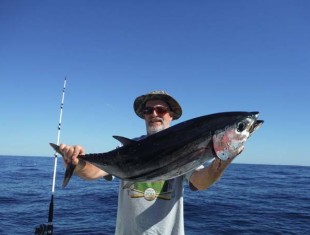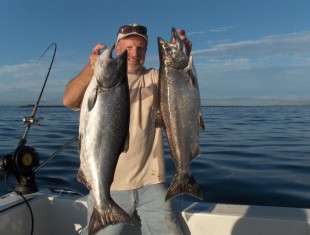By Earl Sande
One of the strangest fish in the sea – the goosefish ‑ has had many names over the past two thousand years and was even considered evil by superstitious fishermen many years ago.
Once, Swedish fishermen believed that if a goosefish was accidentally brought on board someone on the boat would soon die. If they cut the line before the fish broke the surface they believed everyone on board would be safe. And some old time Massachusetts fishermen figured that a huge storm would engulf them if they boarded a goosefish.
An adult goosefish can be six feet long and weigh 130 pounds. Its appetite and digestive system has stunned scientists for hundreds of years. It has lots of teeth, a huge mouth with its head making up about half its body mass.
A goosefish will pretty much eat anything as big or bigger then themselves. Rays, flounder, whiting, haddock, baitfish, starfish, worms, shrimp and crab are just a few of the creatures on their diet plan. They even eat sea birds floating on the surface or when diving after small fish.
One once was cut open reveling seven ducks in its stomach, and they have even been known to swallow geese bobbing in the ocean waves ‑hence the name “Goosefish.”
It gets even weirder. Years ago when there were lots of these strange fish off the Northeast Coast, lobster fishermen would curse them because they would sometimes swallow their wooden lobster trap buoys.
Over a 100 years ago near Ireland a fisherman reported these fish swallowing his cork fishing buoys. The same fisherman was quoted in a local newspaper saying, “But the most remarkable instance I ever knew of this fish’s voracity was it’s swallowing of a large block of granite used as an anchoring stone for fishing. The only reason I could imagine for its seeming want of taste was that the stone had been used as a block to cut up fish for crab-pots, it being consequently covered with blood, slime and scales.”
Once a goosefish nearly fills its entire body with food it doesn’t have to eat again for a long time. Their weak digestive system works extremely slow. A Massachusetts fisherman once caught one that had several dozen herring in its stomach. After gutting out the fish and seeing that the herring looked as good as new he took them to the fish market and sold them as fresh caught.
Another fishermen cleaned one 24 hours after he caught it and all the bait in the fish’s stomach looked perfect.
Today the goosefish is more commonly called a monkfish and is one of the hundreds of species of anglerfish that live in the ocean worldwide. Some other names are sea devils, frogfish, allmouth, molligut, sea toad and football fish, just to name a few.
Goosefish evolved over 130 million years ago into many species of various shapes and sizes with lots of different life cycles and characteristics. Anglerfish, for example, range in size from six inches to six feet, and various other species inhabit water ranging from near shore to 12,000 feet deep.
One thing most anglerfish have in common is their fishing pole; this spine protrudes above the fish’s eye and has a growth of flesh on the end. They can move it in all directions and wiggle the end, attracting small fish. If anything contacts the end of their little fishing pole an auto-reflex will happen lightning fast, sending the tasty morsel to an even darker place to be eventually digested.
The goosefish has an unusual reproductive cycle. In late spring they swim close to the surface near shore basking in the sun for the mating season. A million fertilized eggs are protected in a thin sheet of transparent mucous as much as 30-feet long and five-feet wide, weighing about 30 pounds. Soon tiny embryos can be seen wriggling in the strange looking veil, eventually escaping into the water to fend for themselves. As is the story with most marine life, few will make it to adulthood.
Some species of deep water anglerfish have an even stranger reproductive way of doing things. In the very deep, very dark cold ocean it’s hard to find a mate. So many millions of years ago they found a way that works.
When the male is very young his sense of smell is highly developed, and when he smells a female he heads her direction and sinks his sharp teeth into her underside near the head. Eventually he becomes part of her for the rest of his life. In time all his body parts will disappear except for his testicles that she can use anytime she wants to reproduce. She will probably have more then one set of testicles hanging from her, kind of like an extra spare tire.
People have eaten various species of anglerfish for hundreds of years or longer, but not in America until maybe the last 40 years or so.
Some people say the goosefish tastes somewhat like lobster. But in 2010 Greenpeace International put anglerfish on their red list, which means some of the species have a high risk of being over-fished.
The anglerfish is certainly unusual and it makes you wonder what other fascinating creatures live in the ocean that we haven’t discovered yet.


